Archibald Knox (designer)
Archibald Knox (9 April 1864 in Cronkbourne[1] near Tromode, Isle of Man[2] – 22 February 1933 in Douglas, Isle of Man), was a Manx designer of Scottish descent. He is best known as being Liberty's primary designer at the height of their success and influence upon UK and International design[3] (to the extent that in Italy, Art Nouveau was known as Stile Liberty). Knox's pioneering and prolific work bridged the Arts and Crafts Movement, Celtic Revival, Art Nouveau, and Modernism.[4][5]
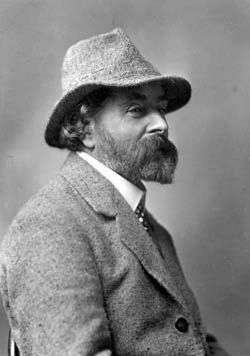
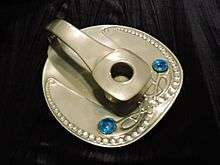
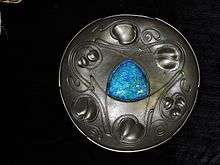
Knox's hundreds of designs for Liberty made his style widely known,[6] (though not his name, as Liberty kept their designers anonymous). Most of his work for Liberty was for the Tudric (pewter) and Cymric (precious metals) ranges. The gravestone of Liberty founder, Arthur Lasenby Liberty, was designed by Knox.
His design talent covered a wide range of objects, ornamental and utilitarian, and included silver and pewter tea sets, jewellery, inkwells, boxes, gravestones, watercolours, graphic designs, calligraphy, a house design, fonts and even bank cheques.[7]
Family background
Knox's father, William Knox, was living in Kilbirnie when he married Ann Carmichael from Lismore Island in 1853. They had moved to the Isle Of Man in 1856 with their firstborn, Robert, where William "an exceptionally ingenious cabinet and machine-maker, joined Moore’s Tromode Works, makers of high quality herring nets and sailcloth."[8] William's sister Margaret had been the first Knox to move to Man when she married a Manx fisherman, William Callister in 1856. William Knox later started his own firm "William Knox’s Engineering Works" and was joined in his enterprise by four of his sons - Archibald pursuing his own career in art. Besides running a successful steamboat and ferry business, the Knox family mechanised the local fishing fleet, were pioneers in industrial electric lighting on Man and introduced the first motor car to the island. Knox's engineering background may have influenced his design process in that his metalwork designs were produced in the style of ready-to-engineer blueprints.
Education
Archibald, the Knoxs' 5th child (and 5th son), started his schooling at St Barnabas Elementary School, and then attended Douglas Grammar School. At the age of 16 in 1880 Knox enrolled at the newly-opened and innovative Douglas School of Art. The students there considered themselves 'venturesome modernists'.[9] In 1889 Knox was awarded his Art Master's Certificate.[9] During his youth Knox developed a lifelong interest in Celtic art, particularly the carved Celtic and Norse stone crosses on the Isle of Man which date from c.500AD to c.1200AD. In 1893 The Builder published Knox's article, 'Ancient Crosses in the Isle of Man'.[10]
Career
Knox starting teaching at Douglas School of Art in 1884, while still a student. In 1896 or 1897 Knox was working for / studying with the pioneering designer Christopher Dresser in London.[11] In 1897 he started teaching at Redhill School of Art where his friend A. J. Collister was principal, leaving with him for the Kingston School of Art in 1899.[12] In 1897 Knox also began designing for the Silver Studio.[13] Then, from 1900 to 1904 Knox returned to the Isle of Man, and produced over 400 designs directly for Liberty of London.[14] Then he returned to teach at Kingston Art School (and Wimbledon Art School 1906/7), again following his friend A. J. Collister.[12]
Knox resigned from his post as Head of Design at Kingston School of Art in 1912 following criticism of his teaching. About twenty of his students also quit and set up the Knox Guild of Design and Crafts. Knox was the Master of the Guild and would return to Kingston to exhibit with them. In 1913 he spent a year in the United States, and on his return to Man acted as a censor of internees' letters during World War I.[15] In 1919, after the War, he again took up teaching art at some of the Isle of Man's schools until his death.[16] Knox also produced a variety of design work on the Island for publications, illuminations, and gravestones.[17]
Knox's great late work was an illuminated manuscript titled 'The Deer's Cry'.[18] Each page is a complex interlaced illumination of a line of the prayer known as 'The Deer's Cry' or 'Saint Patrick's Breastplate'.[19][20] The style, imagery, and colouring of each page reflects the content of each line of the prayer.[18][21]
Design principles and teaching methods
Knox told his students a large number of maxims that give an insight into his design principles. Perhaps the primary one was “Aim at order, hope for beauty”.[22] Knox wrote on the blackboard for new students, “Never be ordinary, better be nothing than that”. Another maxim was, “Art is in everything if we choose to put it there”.[23] In 1912 Knox wrote to a student “Don’t slacken in your work: work and think – think and work: that is the royal road: there is no other through the forest of art”.[24]
Knox had an innovate method of teaching art: he collected a set of three thousand glass slides, of examples of design work, to show his students. While showing these he encouraged the students to consider the design principles involved in each, and whether the design met the functional requirements.[25]
Death and commemoration
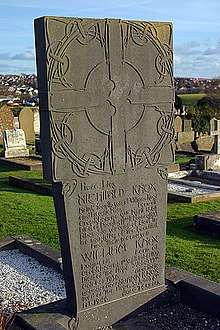
Knox died of heart failure in 1933 and was buried in Braddan Cemetery. His epitaph reads "Archibald Knox. Artist. A humble servant of God in the ministry of the beautiful".
Cadran Cottage, Ballanard Road in Douglas, remodelled c.1910 with design by Knox, was listed as a Registered Building of the Isle of Man in 1996.[26] The word Cadran means quadrant on a sundial.
The first international touring exhibition of Knox's work was in 1996-1998.[27]
The Archibald Knox Society was founded in 2006. The aim of the Society is the education of the public worldwide in relation to all matters concerning the legacy of Knox.[28] To this end the Society has given lectures, (including an international tour), published journals and helped to organise exhibitions.
To celebrate the 150th Anniversary of Knox's birth, the Isle of Man Post Office issued a set of 10 stamps featuring his designs, released in April 2014.[29] Also in 2014, an exhibition exploring the work of Knox and his Celtic contemporaries ("Celtic Style") was held at the House of Manannan, Peel, Isle of Man. A commemorative concert was held at Peel Cathedral featuring newly composed harp music and also including Manx Gaelic choir music. An exhibition of Knox's work was held at the 42nd Olympia International Art & Antiques Fair in London in 2014.
External links
- The Archibald Knox Society
- 'The Deer's Cry' / 'St Patrick's Breastplate' by Archibald Knox
- 'The Deer's Cry' / 'St Patrick's Breastplate' - each illumination shown with corresponding words of each line of the prayer
- Manx National Heritage - Bibliography of Knox resources
- 'Archibald Knox, Liberty of London and Modernism'
- Winifred Tuckfield, (1916) 'Archibald Knox' in Mannin vol 7 pp381/384.
Gallery
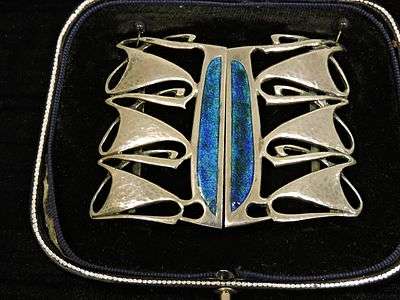 Belt buckle designed by Archibald Knox.
Belt buckle designed by Archibald Knox. Lhergy, watercolour on paper (1900–20)
Lhergy, watercolour on paper (1900–20) Inkwell designed by Knox
Inkwell designed by Knox An 'easel' clock style 0608 designed by Knox
An 'easel' clock style 0608 designed by Knox Sweet dish designed by Knox
Sweet dish designed by Knox- Tea service designed by Knox
 Pewter candlestick designed by Knox
Pewter candlestick designed by Knox Knox illustration of 'Castle Rushen' by Armitage Rigby.
Knox illustration of 'Castle Rushen' by Armitage Rigby.
References
- Archibald Knox 1864-1933
- About Archibald Knox Archived May 12, 2008, at the Wayback Machine
- "Chronology: Archibald Knox 1864-1933". Archived from the original on 2016-02-25. Retrieved 2016-04-14.
- Archibald Knox, Liberty of London & Modernism
- Celtic Style exhibition celebrates 150th anniversary of the birth of Archibald Knox
- Adrian J. Tilbrook, The Designs of Archibald Knox for Liberty & Co., 2000, p. 113, no. 95
- Archibald Knox - Isle of Man Government Manx National Heritage: Archived March 2, 2012, at the Wayback Machine
- "Chronology: Archibald Knox 1864-1933". Archived from the original on 2016-02-25. Retrieved 2016-04-14.
- Tilbrook, Adrian J, 'Knox, The Early Years' in Stephen A Martin, Archibald Knox,, 2001
- Knox, Archibald 'Ancient Crosses in the Isle of Man' in 'The Builder' 30 September 1896 pp. 243-246. (Includes sketches of the designs on Manx Crosses)
- Adrian J Tilbrook, 'Influences and Designs', in Martin, S., 'Archibald Knox' (2001) p.58.
- "Archibald Knox 1864-1933". Isle-of-man.com. 1933-02-22. Retrieved 2018-09-09.
- Mark Turner, 'Archibald Knox and the Silver Studio', in Martin, S., 'Archibald Knox' (2001) p.53
- Adrian J. Tilbrook, The Designs of Archibald Knox for Liberty & Co., 2000
- "Archibald Knox (1864-1933) | Knockaloe Virtual Museum and Archive". Knockaloe.org.uk. Retrieved 2018-09-09.
- "Archibald Knox Biography - Infos - Art Market". Archibald-knox.com. Retrieved 2018-09-09.
- Stephen A. Martin (Ed.), Archibald Knox, 2008.
- Stephen A. Martin (Ed.), Archibald Knox, 2008
- "The Deer's Cry by Archibald Knox | PDF to Flipbook". Youblisher.com. Retrieved 2018-09-09.
- "Deer's cry posters | Deer's cry prints". Magnoliabox.com. Retrieved 2018-09-09.
- "Archibald Knox". IoM Post. Retrieved 2018-09-09.
- Knox the Person (2017-12-12). "Archibald Knox | Knox the Person". Archibaldknoxforum.com. Retrieved 2018-09-09.
- Knox the Person (2017-12-12). "Archibald Knox | Knox the Person". Archibaldknoxforum.com. Retrieved 2018-09-09.
- Knox the Person (2017-12-12). "Archibald Knox | Knox the Person". Archibaldknoxforum.com. Retrieved 2018-09-09.
- Rosemary D.Wren 'New Light From Old Records - Archibald Knox's approach to his work', in Martin, S. (ed) (2001) 'Archibald Knox', Artmedia, London
- "Registered Building No. 166 / Cadran Cottage, Ballanard Road, Douglas" (PDF).
- Martin,S.(2001)'Archibald Knox' Artmedia, London
- "Archived copy". Archived from the original on 2017-09-11. Retrieved 2017-09-10.CS1 maint: archived copy as title (link)
- "Archibald Knox Celtic Style Celebrating the 150th Anniversary of his Birth". Isle of Man Post Office. Archived from the original on 22 March 2014. Retrieved 21 March 2014.
| Wikimedia Commons has media related to Archibald Knox. |